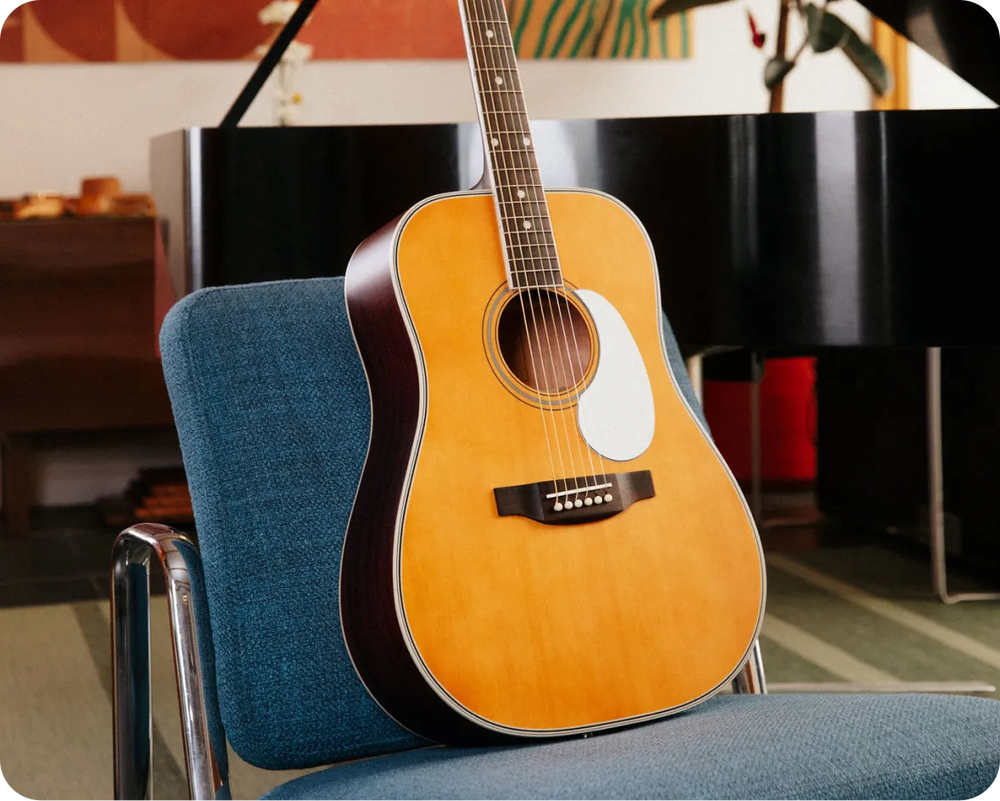
It’s the great debate that prefaces every Orangewood purchase. A lot of our fan-favorite guitars come in two options: mahogany and spruce. It’s hard to choose, because they’re both aesthetically pleasing, but there’s more differences once you look past the surface.
By the time you get through this article, you’ll have all of the information you’ll need to feel confident in the type of wood you decide on — or maybe you’ll find yourself wanting two more guitars for your collection!
The Look
Let’s start with the obvious. It’s impossible to miss the visual differences between our solid mahogany and spruce tops.

Check out the visual differences between our Ava Torrefied Spruce (Left) and our Ava Mahogany (Right).
Mahogany is a dark wood with a more distinct grain pattern. This gives each guitar a subtle, yet recognizable pattern that can vary between instruments. All of our guitars come with either rosewood or pau ferro back & sides (on the Topanga and Melrose Collections) or mahogany back & sides (on the Highland and Overland Collections), meaning the whole guitar will be composed of dark wood. Our guitars with solid mahogany tops are visually striking and stand out among the competition for that reason.
Spruce is a light wood with a subtle grain pattern. This wood gives our guitars a more “classic” look, as spruce is the most popular top wood across the board for acoustic guitars. Spruce will contrast with the dark wood (pau ferro, rosewood, or mahogany) back & sides, which gives it another dimension of aesthetic charm. Overall, going with a spruce top is a great choice for someone chasing the prototypical acoustic look.
For beginner guitarists, it’s recommended that you choose based on the guitar's visual appeal. After all, if you love the way the guitar looks, you’re going to feel inclined to pick it up and practice more often. That’s not to say there aren’t any differences in the way the wood types sound, but the differences are relatively slight; they will be harder to notice unless the listener has experience in comparing guitar tones. What are those differences? Well, let’s get into it...
The Sound
When it comes to the tone of each top wood, there are subtle, yet defining differences that can make or break the decision making process for a musician with a trained ear. While both mahogany and spruce are commonly used on acoustic guitar tops for their rich and full sound, let’s go over what you might notice if you listen to them side-by-side.
Want a deeper dive into the sound? We put our tonewoods to the ultimate A/B test on this episode of "Tone Testers"
Mahogany topped acoustic guitars are mostly known for what musicians describe as a “smooth, subdued” sound. While some may say that mahogany is “less bright” or “warmer” than spruce, you might notice that the high-end frequencies are still very present with the mahogany guitar. However, because of the lower response of the mahogany, there is an overall mellow and soft presence to the sound.
Spruce tops, on the other hand, project much more than mahogany. This creates that classic acoustic presence: loud and punchy. Once again, you’ll distinctly hear the highs, mids, and lows present with the spruce top, but the volume and responsiveness might make it “feel” like it is brighter than mahogany to some listeners.
Keep in mind that these terms used to describe tone are often subjective to an individual’s ears. That’s why you should judge the tone based on which sound you prefer. Take comfort in knowing that either way, you’re choosing a versatile guitar that can do it all.
What About Torrefied Spruce?
Now, let’s add in a layer of complication. Say your ideal acoustic guitar tones are found in vintage spruce guitars; you’re looking for that classic spruce sound that has mellowed out with age, becoming a touch woodier and warmer. Well, your dream can come true without needing to shell out for the vintage price tag: look no further than our torrefied wood. Through a baking process called "torrefaction," we imbue our solid Sitka spruce with an aged look and sound while maintaining the benefits of our modern appointments.
Settle the Debate: Which Wood Would You Choose?
The choice between mahogany and spruce can be tough when it comes to purchasing an Orangewood; they’re both beautiful sounding and incredible looking tops. It all comes down to personal preference: can you see yourself rocking the stage with the dark Ava Mahogany, or is the more classic Ava Torrefied Spruce suited to your tastes? Either way, if you end up with a guitar you love, you'll know you made the right choice!




